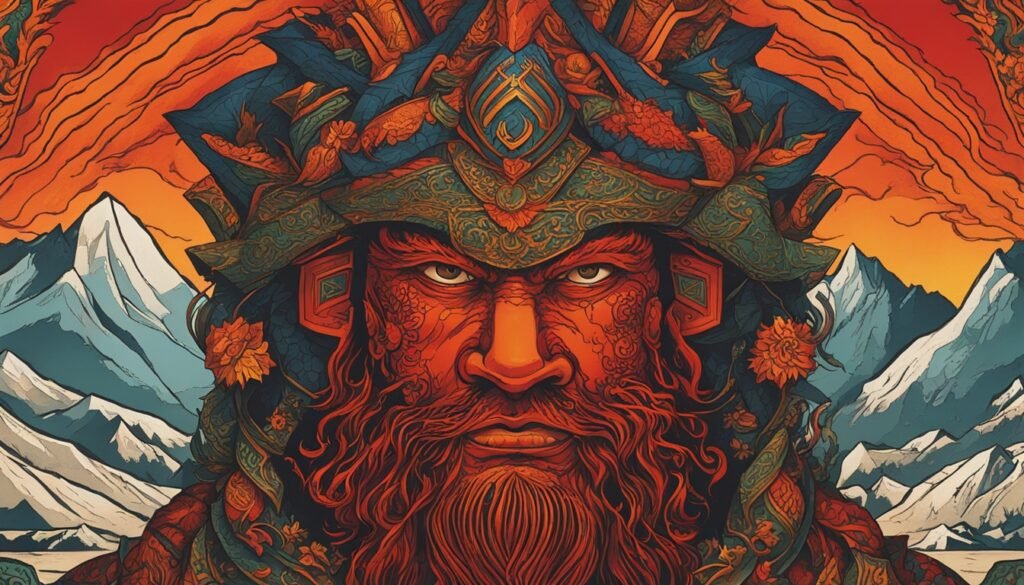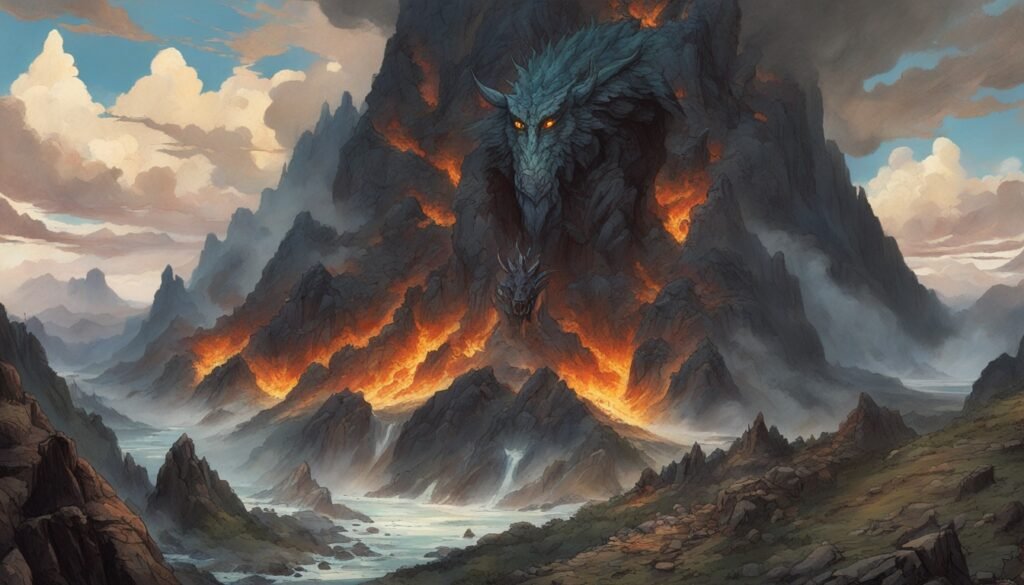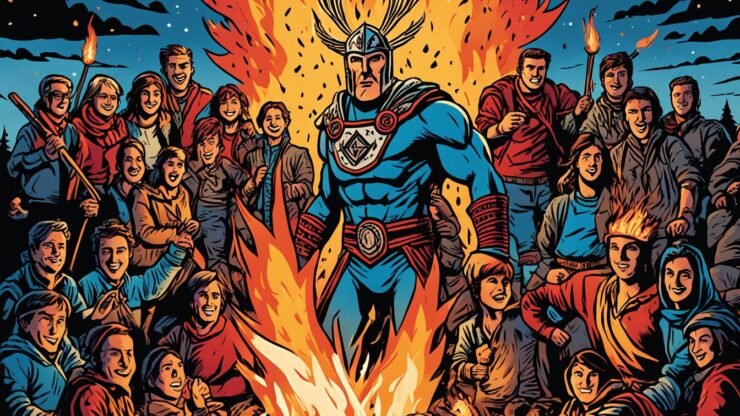In the northern Luzon’s rugged Cordillera Mountains, a mythic hero shines. Gisurab, the fire-possessing giant, is the heart of Isneg folklore. He represents a vibrant cultural past for the Isneg people.
The Isneg, or Isnag, live amidst the Philippines’ mountainous terrains. This group of resilient people have a history of toughness. They took root in the wild’s heart for survival reasons. Early Spanish colonial records named them “los Apayaos,” tying their name to their land’s river.
In this majestic yet rugged land, Gisurab became a legend. Being a fire-possessing giant, his tale is pivotal in Isneg culture. It showcases the Isneg’s view of giants, differing from the usual ‘evil’ image.
Key Takeaways
- Gisurab is a mythical fire-possessing giant from the Isneg folklore in the Philippines.
- The Isneg are an indigenous people who live in the northwest of northern Luzon, in the Cordillera region of Apayao Province.
- Gisurab is a significant figure in the cultural beliefs and traditions of the Isneg people.
- The legend of Gisurab offers a unique perspective on the role of giants in Philippine mythology.
- Gisurab challenges the common perception of giants as inherently evil or destructive.
Introduction to Philippine Mythology
The Philippines are full of cultural stories, including mythological creatures. These creatures, like giants and ogres, come from the tales told over many years. They fall under what expert Dr. Maximo D. Ramos calls “lower mythology.”
Creatures of Philippine Lower Mythology
In the Philippines, there are many kinds of mythological creatures. Every one of its 140 ethnic groups adds its own twist to these stories. For example, there’s the aswang, a fearsome creature that can transform into others. And don’t forget the duwende, small magical beings that call the land their home.
Giants or Ogres?
The giants and ogres of Philippine mythology stand out. They are huge and sometimes look like us. Giants prefer to live far from people, while ogres live close by and eat humans.
Some Philippine giants like the simian-tailed Ikugan look more animal than human. Even though they are very strong, giants and ogres are often shown as not too bright. This makes it possible for others to trick them.
The Kind-Hearted Giants
In Western tales, giants are often seen as mean and harmful. But not all giants in Philippine folklore fit this view. For example, Gisurab, a giant from the Isneg tribe, had a heart of gold. When hunters came to him for fire, he didn’t turn them away. He gave them fire to cook their meals. This kind act is much like Prometheus in Greek myth giving fire to humans.
Gisurab: The Fire-Possessing Giant
The Gisurab story tells us about his kind-hearted side. He helped hunters cook by sharing his fire. This shows big creatures, like him, can be very kind and generous. Such acts are valued in Isneg culture.
Sibbarayungan: The Kind Giantess
There’s also Sibbarayungan, a Isneg giantess known for her kind and compassionate ways. She used her strength to keep the Isneg people safe. This shows giants in Isneg folklore aren’t all mean and destructive.
The Mischievous and Malevolent Giants
In Philippine mythology, giants vary. Some are kind, but others are not. There’s Ikugan, a giant from Manabo tales. It’s massive, like a monkey, and has a long tail. It grabs and chokes people, dropping them from trees.
Ikugan: The Man-Eating Simian Giant
Ikugan, from Manabo stories, is a mischievous giant. He’s huge, simian, and uses his tail to kill. Victims meet their end this way. He’s a serious danger in the forest, a feared creature Philippine folklore.
Bungisngis: The One-Eyed, Ever-Grinning Giant
Bungisngis, a mischievous giant, is famous in the Philippine folklore. He’s huge with one eye, and he always smiles. This malevolent giant tricks people to their doom with his grin. His tricks and evil ways make him feared and interesting in Philippine mythology.

Giants as Gods and Creators
In some Philippine myths, giants are seen as powerful creators and divine beings. For example, the Iloko creation myth talks about Angngalo and Aran, the first giant man and woman. The story highlights how these giants are both creators and deities in the rich folklore of the Philippines.
Angngalo and Aran: The Iloko Creation Myth
According to the Iloko myth, Angngalo and Aran were immense giants. They are said to have started the human race and shaped the world. This story not only explains the Iloko creation myth but also shows how important giants as gods were in the Iloko culture.
Parallels in Chinese and Norse Mythology
This idea of giants as gods and creators appears in Chinese and Norse myths too. These myths often feature massive beings as the makers of the universe. It seems that many cultures share a fascination with the concept of giants as gods.
| Mythological Tradition | Giants as Gods and Creators |
|---|---|
| Iloko Creation Myth | Angngalo and Aran |
| Chinese Mythology | Pangu |
| Norse Mythology | Ymir |
The story of giants as gods and creators in Philippine myths, like the Iloko myth, shows their lasting impact on Filipino belief.
The Isneg Tribe and Their Legends
The Isneg people live in the northwestern part of northern Luzon. This area is part of Apayao Province in the Cordillera region. They are also known as the Isnag or Apayao. Their name comes from words that mean “recede” and “interior”. This refers to how they moved to the quiet interior lands long ago.
History and Culture of the Isneg People
The Isneg have a culture full of life and history. They are famous for making detailed fabrics and wood carvings. They deeply love their land and use old farming and hunting ways to live.
Even with the world changing, the Isneg keep many old ways alive. They speak a special language and tell stories from the past. Their ability to stay true to themselves shows their strength.
The Isneg share many legends by word of mouth. These tales have mythical beings and fire giants, like Gisurab. They are key in the Isneg culture and beliefs.

Learning about the Isneg history and culture adds colors to Philippine myths. It helps us value the lasting mark of native communities.
Gisurab and the Isneg Tradition of Hospitality
Gisurab, a fire-possessing giant from Isneg tales, shows us a lot. Not only is he kind, but he also teaches us about Isneg tradition of hospitality. When hunters needed fire, Gisurab didn’t hesitate to help. He gave them the flames necessary for cooking. This move highlighted Isneg’s values of hospitality and compassion.
The Isneg, or Isnag, are native to northern Luzon’s far northwest, Apayao’s Cordillera region. They treasure legends like that of Gisurab, passing them from one generation to the next. These tales shed light on the cultural values influencing their life.
The Isneg tradition of hospitality is at the core of their beliefs. It plants the seed for harmonious coexistence. By accepting and helping strangers, even powerful ones like Gisurab, they foster friendships and a shared sense of community.
The story of Gisurab and the Isneg’s commitment to hospitality and compassion is still praised. It underlines the depth and diversity of Philippine mythology. It also reminds us of the Isneg people’s rich heritage and their dedication to keeping its spirit alive.
Giant Folklore: Fact or Fiction?
People have debated the existence of giants for a long time. Some say they’ve found giant human bones all over the world, even in the Philippines. Yet, most experts believe these findings are false or mistaken.
Alleged Giant Skeletal Remains
Finding giant human bones has sparked much curiosity. Stories have come from places like Japan, South America, and the Philippines. Yet, without real evidence, many dismiss these claims as untrue stories or wrong identifications.
Emotional Release for Children
Even though science can’t prove the existence of giants, their stories still capture our hearts. In Philippine mythology, tales of giants illustrate how cleverness and willpower can win over brute strength. They teach us important lessons about life.
The Enduring Legacy of Giant Lore
The tales of giants in Philippine mythology have lasted for ages. They have fascinated people all over the nation. Giants, good or bad, are a big part of Philippine cultural heritage.
Take, for example, the fire-wielding giant Gisurab of the Isneg tribe. Or the huge and hairy Kapre deep in the woods. These stories not only show how varied Philippine myths are. They also remind us of the huge impact folklore has on our culture.
The Philippines is very proud of its mythological heritage. The legends of giants, good and bad, will surely be shared for many more years. They will keep the magic of the giant lore alive for future generations.

Conclusion
In Isneg folklore, Gisurab shines as a fire-possessing giant. He shows us Philippine mythology‘s diverse nature. Gisurab aids those in need, challenging the idea that giants are always bad.
Gisurab’s story reveals the good side of giants in Philippine folklore. It also shows the importance of helping others, a value dear to the Isneg community. This giant lore remains treasured, giving us a peek into Philippine cultural richness.
Exploring Philippine mythology unveils giants as complex beings. They can be both scary and kind. Gisurab‘s tale especially remains beloved. It shows how such stories keep intriguing us across generations.

